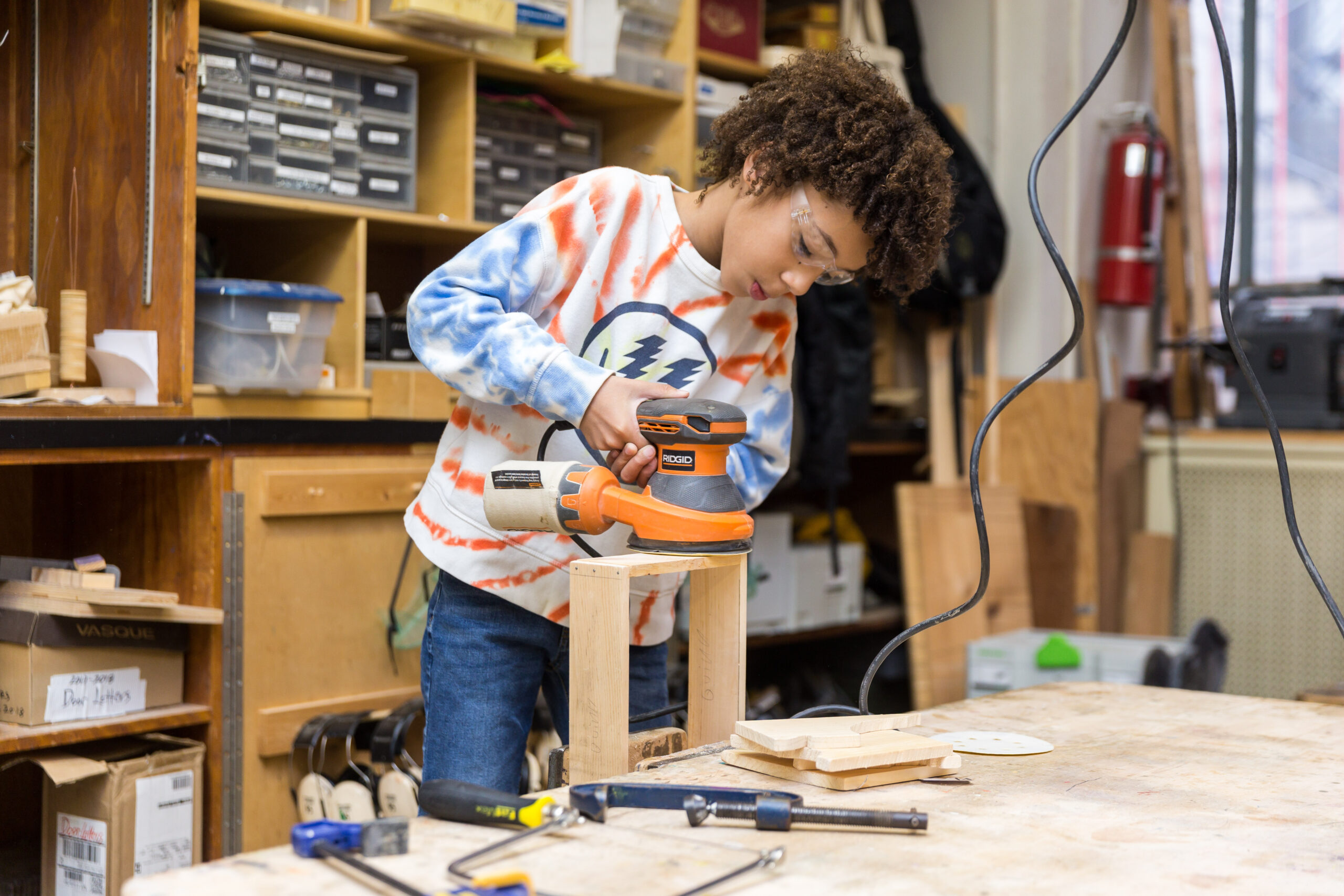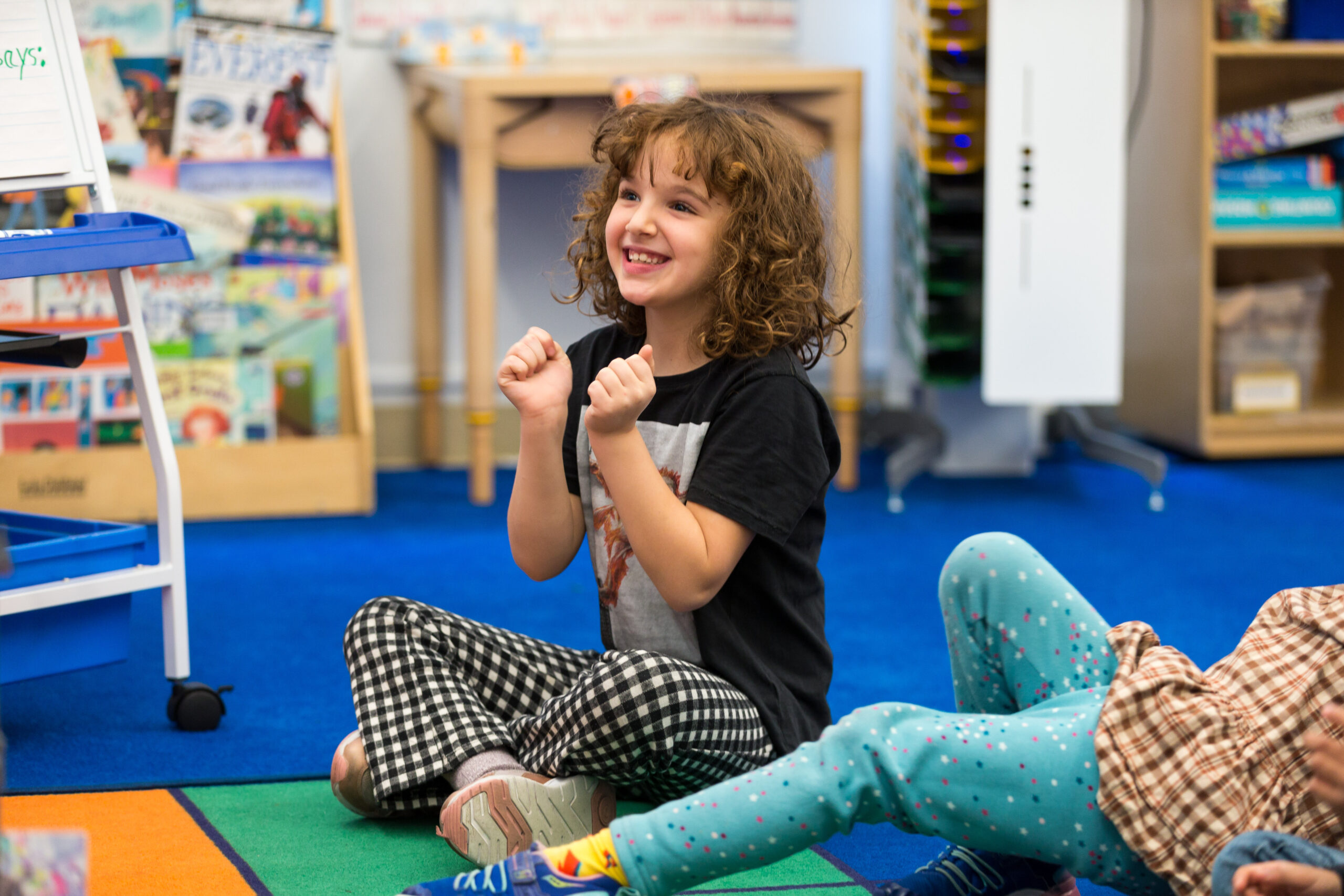Lower School Classes and Programs
Language Arts
The Language Arts curriculum employs a variety of approaches to ensure that children acquire proficiency in reading, writing, and oral presentation as they develop a love of literature and learn self-expression skills through the written word. Each student is encouraged to develop confidence as both a reader and an author, capable of communicating information and creative ideas. Students are introduced to a wide variety of literary genres and literature representing diverse cultures.
Recognizing that not all children learn in the same way, reading skills are taught through a variety of approaches that combine the building of sequential skills, including:
- the development of a sight vocabulary
- the use of phonetic clues
- building fluency
- independent reading in school and at home
- strategies for word attack
- the use of visual clues
- the importance of reading for meaning
- non-fiction reading strategies
Writing lessons are closely connected to reading. If the current focus in reading is a folktale or poem, students may subsequently write in that genre. In every classroom, a writing process is emphasized in which students think of an idea, write a draft, revise it, edit their work, and publish it. Lessons are designed to build writing process skills with spelling and handwriting often taught within the context of the child’s own writing as well as within a program of sequentially introduced skills. Books authored by students are displayed in the classroom and are often a popular choice during independent reading times.
Mathematics
Our beliefs about math education:
Math is for everyone. We strongly believe that all students have important mathematical ideas. We do not believe that someone is or isn’t a “math person.” This is rooted in our commitment to approaching math education through a growth mindset. Every math learner has areas where they excel and are confident and areas where they are developing and growing.
We believe that math is a discipline based on sense-making. Our classrooms are not primarily structured around teachers presenting steps for how to solve a problem, but rather teachers presenting and facilitating carefully chosen problems, scenarios, puzzles, and games that invite creativity and help students build new understanding. We believe that thoughtfully chosen visual models and physical manipulatives, such as ten-frames, arrays, and pattern blocks, are instrumental in developing mathematical knowledge for all learners.
We value the development of the content and skills of numbers, shapes, and data, and also the practices of pattern seeking and perseverance. We strive to create classrooms where each learner’s important math ideas are valued and heard, and where we practice the art of communication with others to share our thinking and learn new perspectives.
Learning mathematics is not a straight, linear journey, but rather is complex and multi-faceted. Students build strength in their understanding from making connections to different areas of mathematics. We seek to discover where each student is on their own math learning journey. As teachers we seek to provide experiences that both engage and stretch our students wherever they are.
Our curriculum:
Bridges in Mathematics (2nd edition), published by the well-regarded Math Learning Center, is our primary curriculum source for our scope and sequence. Bridges is aligned with the Common Core State Standards for Mathematics and receives top reviews for its cohesiveness and accessibility. We also support and enrich with other resources as needed, often inspired by a network of math educators from around the world including the National Council of Teachers of Mathematics (NCTM). Our curriculum is dynamic as we try new things and respond to the learners in front of us.
Social Studies
Our Social Studies curriculum is premised on a progression of awareness and understanding that gradually expands a child’s view of him or herself and the world. The program emphasizes human interdependence within communities, fostering a respect for different cultures and responsibility for the environment.
In kindergarten, children explore the concepts of self, family, and school community. The first grade studies systems and institutions in our neighborhood. Brooklyn (its geography, landmarks, and ethnic groups) is the topic for second graders, the third grade learns about Native Americans, and fourth graders study the early voyages of explorers, the New World, and the settlement of New Amsterdam.
Science
The science program is based on each child’s natural curiosity about their world and their need to explore, ask questions, and search for answers. Children develop their skill at using the scientific process: making careful observations, hypothesizing, developing appropriate tests and understanding variables, recording observations and data, drawing conclusions, and evaluating data.
The Lower School science specialist works in conjunction with classroom teachers to design and implement units of study in our Lower School science lab. The primary goal of the curriculum is to help students learn to think scientifically. Topics covered at each grade level include seeds, magnets, metamorphosis, classification, simple machines, the water cycle, and electricity – all to help students develop a solid core of scientific knowledge.
Field trips are also an important part of our science curriculum and take advantage of the rich resources the city has to offer, such as the Aquarium, seashore, New York Hall of Science, Museum of Natural History, Prospect Park, and the environmental Sloop Clearwater. Trips outside the city include visits to environmental centers and a three-day, two-night camping experience for third and fourth graders.
Spanish
All K-4 students have Spanish language instruction with the Lower School Spanish teachers. Children are introduced to basic vocabulary, expressions, and the cultural traditions of countries where Spanish is spoken. They sing songs and play games in Spanish, view videos in Spanish, and practice interactive dialogues in Spanish.
Children also begin to gain facility with Spanish by learning the vocabulary associated with their curricular studies in other academic areas through intentional correlation with each grade’s social studies, science, and language arts curricula. First graders who study neighborhood and community will follow that study by learning the Spanish names for different stores and people in our Brooklyn community.
Library
The mission of our Lower School library program is to ensure that students become effective users of ideas and information by integrating classroom studies of literature, social studies, and science with the instruction of research skills. Through active participation in storytelling, bookmaking, and dramatizations, our library program promotes a love of literature and encourages students to become critical thinkers and lifelong readers. Students learn how to conduct and evaluate research in print formats and online databases, and they receive guided instruction in the use of the Internet, both in formal small groups and during independent study.
Information Technology and Media Literacy
Third and fourth grade students have one formal class session in Information Technology and Media Literacy each week, where they are introduced to the computer as a multi-faceted tool in their learning process. Focus areas including network navigation, touch-typing, and working with multimedia support the development of logical-processing skills and higher order thinking. Students are guided in the appropriate and responsible use of information technologies and resources.
Technology
Technology is integrated into the classroom curriculum for our Lower School students. A class set of iPads is available at each grade level, and apps are thoughtfully chosen by teachers to ensure they are developmentally appropriate and pedagogically sound for use by our young students. Students use their iPads to research, collaborate, create, and demonstrate their thinking.
In addition, third and fourth grade students engage in technology classes on a weekly basis using both iPads and Chromebooks. Topics covered include digital citizenship, cloud computing, design thinking, 3D design and 3D printing, web design, computational thinking and coding, digital media and augmented reality. Our technology and library departments work closely together with classroom teachers to help students develop the research and technical skills necessary to navigate and understand the world of digital information.
S.T.R.E.A.M. activities, through the collaboration of the science, technology, library, art, woodworking, and math departments, make up an important component of the technology program at Brooklyn Friends School. Students learn to use the tools they have developed from the various areas of study to solve and persist through authentic and real life problems. Some of these activities include the invention of a product for the use by the community and the creation of a neighbourhood for a small robot that the students learn to navigate with code. Through this integrative process, students enhance their skills in critical thinking, collaboration, communication, and creative thinking.
Dance
At BFS, dance units are often connected to science, social studies, or language arts studies. Students explore the elements of dance, build movement vocabulary, and work together to create original dances, starting in kindergarten and first grade, learning fundamental locomotor movements and making dances based on poems, stories, seasons, and classroom themes. Second graders investigate the different ways water moves as well as the body coordination of ocean animals, and in third grade, students explore spatial formations and create a dance based on a Native American myth. Fourth graders present an annual Halloween Dance that they choreograph and help produce for Pre and Lower School audiences as well as their parents.
Music
Children experience many types of music as they learn more about its elements: dynamics, tempo, rhythm, pitch, timbre, form, texture, and harmony. Singing and movement are integrated in the class through games, and students learn to read and sight-sing music through solfege and hand signs.
In kindergarten and first grade, children explore different ways to perform beat and rhythm and begin to read rhythmic notation. Older classes continue their introduction to rhythmic and melodic notation by reading and writing known songs and by notating their own compositions. In fourth grade students learn to play the recorder.
Our music program is a composite of the Kodaly, Orff, and Dalcroze methodologies.
Visual Arts
Our Lower School art program seeks to develop each student’s innate creative abilities by encouraging self-expression and visual awareness. Students explore design, shapes, color, textures, composition, balance, and both abstract and representational themes through the use of paints, craypas, pencils, markers, printmaking, papier maché, and collage.
Sample projects include:
- Kindergarten: collage paintings, styrofoam printmaking, people drawings
- First grade: Big People paintings, collage paintings, cityscape, still-life
- Second grade: cray-pas portraits, papier-maché animals, wire sculpture
- Third grade: imaginary creature collages, parent/child paintings, Native American-inspired papier maché masks
- Fourth grade: Linoleum block printing, pen and ink drawings, paintings inspired by the work of famous artists
Wood Working
Our woodworking program combines manual skills with visual arts concepts. Each class begins the year with a directed project to learn and reinforce skills such as sawing, hammering, measuring, using a square accurately, and increasingly complex mathematical concepts.
Sample projects include: animal shape toys and bookends, lid boxes, and functional furniture. After completion of their directed projects, students independently design their own projects. The design process lends itself towards lessons in the mathematical and engineering aspects of design as well as its aesthetic elements. Emphasis is placed on problem solving, cooperation, respect of materials and tools, and the ability to work independently.
Physical Education
Total body fitness, physical development, and cooperative play are the primary focus areas for Lower School physical education classes. Specific skills include following directions, spatial awareness, agility, endurance, strength, and socialization.
Kindergarten students are taught skills through structured play with an emphasis on large motor movements, such as galloping, skipping, tagging games, and jumping rope. First and second graders are introduced to more advanced ball-handling skills that form the foundation for volleyball, soccer, and basketball. Students take part in cooperative games, gymnastics, track activities, running and dodging games. Because their skills have become more refined, third and fourth graders participate in actual sports, sometimes modified to enhance team play, skill development, and group cooperation.
Health
Third and fourth graders attend regularly scheduled health classes with the health teacher covering topics in nutrition as well as interpreting and constructively demonstrating emotions. Fourth graders discuss the dangers of tobacco, decision-making skills, and puberty/body changes.


